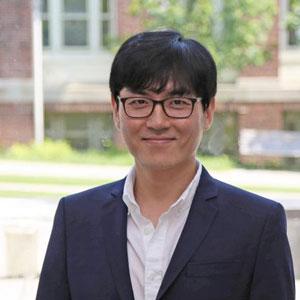Carney Institute (CI): Tell us a bit about yourself.
Jonghwan Lee (JL): I'm an assistant professor of engineering, and assistant professor of brain science. I'm leading a research team here to work at the intersection of medical photonics, neural engineering, and artificial intelligence to develop some technical solutions to pressing medical

problems. We’re an interdisciplinary team made up of people who have very diverse backgrounds from applied mathematics and engineering, computer engineering, biomedical engineering, and neuroscience.
CI: You have a B.S. in physics and a Ph.D. in neuro engineering. Why this career choice?
JL: From a young age, I was interested in understanding the governing principles underlying what we see in the real world. This led me to study physics as an undergrad. Early on, I found that I especially loved electromagnetism. Later, when I learned that neurons communicate with each other electrochemically, I became very interested in the brain. So, I chose to pursue a Ph.D. in neuro engineering which is at the intersection of the brain science and physics. I thought perhaps I could approach brain science from the perspective of the physicist, not from the traditional bio perspective. In my graduate studies, what really drew me in was using machines to interface with the brain, whether that was done electrically, chemically, or using light, optically.
CI: In a presentation that you gave recently, you wrote that Alzheimer's disease is the biggest epidemic in human history. How is your research trying to tackle this issue?
JL: There are many key components for us to fight this disease. One of these is early detection and diagnosis. Often, by the time someone is diagnosed with Alzheimer’s, significant, irreparable damage has already occurred to the brain. Traditionally, detection is based on chemical biomarkers in the brain. Invasive and/or very expensive methods including brain scans and lumbar punctures have been used to find these chemicals.
Our team’s approach is to use cutting edge imaging technology to detect very early changes happening in the brain so that we can predict the disease, even two decades ago before the symptom starts. Specifically, we envision using eye scans to look at the retina.
The retina is full of blood vessels and is part of the central nervous system. Some scientific evidence suggests that when you have some abnormality in your brain blood vessels, like in a patient with Alzheimer’s, very similar abnormalities also appear in your retinal blood vessels.
Along with assessing an individual’s genetic and lifestyle risks, these scans would help a physician predict if a patient has a high probability of developing Alzheimer's disease in 10 or 20 years. These scans would ideally be something that could be done on a routine visit to your optometrist or ophthalmologist every few years. If this routine checkup consistently predicts a high probability for consecutive years, then a physician might consider a more serious test, like lumbar puncture or brain scan.
CI: Does machine learning or artificial intelligence (AI) play a part in this research?
JL: This area of research needs advances in both medical photonics and artificial intelligence. Detecting these types of abnormalities in the blood vessels of the retina can be quite subtle and hard to see. So, we’re essentially using AI to train the machine to analyze these images and then make very accurate predictions.
CI: What are some of the greatest challenges that you’re encountering?
JL: Well, we definitely have a long way to go. First, we have to validate the idea of using animal disease models, which is the current focus of our project. We’re building an artificial intelligence model based on animal data that we’ve acquired and will then test this AI in human data.
For this next part of the test, we need a lot of human eye scan data, both from normal people and Alzheimer’s disease patients, so that we can see blood vessels in the retina at different ages or stages of disease. We are very fortunate to have a clinical partner who is gathering this data from cohorts of patients. I can’t wait to see how our AI works with human data and to tune the AI to work even better. After that, we’re hoping to design an even bigger clinical trial so that we can gather eye scans from a much larger population.
Another challenge is to bring this research methodology out of the lab in a way that works in the marketplace. There are a lot of steps to go through, to make this AI service usable and accessible to the public.
CI: So, at the end of the day, are you optimistic about the Alzheimer's disease detection and treatment?
JL: Absolutely. There’s a universal desire to advance Alzheimer’s disease research and treatment. In the U.S. alone, Alzheimer's costs about $300 billion every year to Medicaid and Medicare, excluding all other private sector money costs. And this will only grow as our population ages. These public costs are expected to balloon to $1 trillion per year which isn’t economically sustainable. Our ultimate goal is to suppress this cost by 1%. Using early prediction technology, we could save $10 billion of the public money every year.
There are so many people, including our team of talented engineers and scientists, who are working on different tools for early detection. In addition, recent advances in artificial intelligence enabling image processing and analysis, including deep learning, are progressing very quickly. And that’s where my optimism comes from.